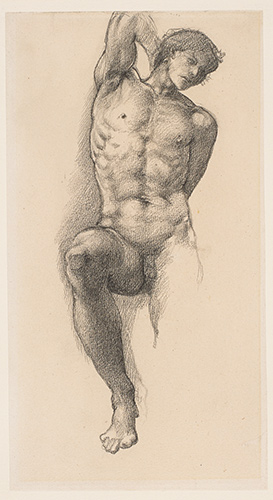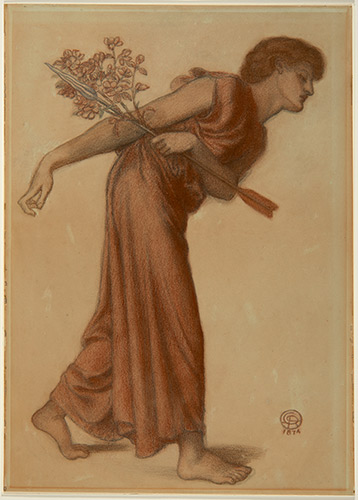Admirers of Victorian art should race to Ottawa to enjoy the exhibition “Beauty’s Awakening: Drawings by the Pre-Raphaelites and Their Contemporaries from the Lanigan Collection.” Organized by the National Gallery of Canada (NGC) and on view October 9–January 3, this show traces the diversity and flair of British draftsmanship during the reign of Queen Victoria (1837–1901). Its title has been borrowed from an 1899 play in which a knight seeks to find and awaken “the Spirit of all things beautiful,” just as these artists did.
A longtime resident of the Canadian province of Saskatchewan, the oral and maxillofacial surgeon Dennis T. Lanigan has spent four decades acquiring Victorian artworks. He has focused primarily on the years 1850–75, when the Pre-Raphaelite and Aesthetic Movements constituted Britain’s avant-garde. Today he owns more than 400 works by roughly 100 artists, principally drawings and watercolors, but also paintings, original prints, sculpture, medals, stained glass, and decorative objects.
Of these, the NGC is presenting 124 drawings representing 57 makers. Among them are the Pre-Raphaelites Edward Burne-Jones, John Everett Millais, William Holman Hunt, and Dante Gabriel Rossetti, the Royal Academicians E.J. Poynter and Frederic Leighton, and other major figures like William Morris, James McNeill Whistler, and J.W. Waterhouse. Their drawings range from preparatory sketches to highly finished scenes exhibited in their own right, and they include pportraits, life studies, landscapes, allegories, and scenes from religious and literary narratives.
“I had no plan to build a ‘collection’ per se,” Lanigan explains. “It basically ‘grow’d like Topsy’ until it took on a life of its own. I have always had an interest in collecting, however: As a boy I assembled a collection of fossils. My first real exposure to great art came in 1972, when I toured the U.K., and it was then I started my habit of exploring the major art gallery of every large city I visited. Upon my graduation from dental school in 1972, my parents gave me $500, so I decided I would spend it on art. Fate intervened when I spotted a Parian sculpture by Minton & Co. at a Toronto antique shop. It was dated c. 1851 and priced at $450, so I bought it. It became my first piece of art, and it just happened to be British and Victorian. Later that year, I stumbled upon a fictional autobiography of Whistler, which introduced me to all the leading artists of his era. In retrospect, I realize that I had already been exposed to famous Victorian painters through illustrations in the literature I read as a child, including the Arthurian stories and Greek myths.”
Lanigan recalls, “In 1976, I arrived in London just in time to see an important Burne-Jones retrospective at the Hayward Gallery. If there is such a thing as a ‘road to Damascus’ for collectors, that was mine. I exited thinking that if I could own even one drawing by Burne-Jones, I could die happy. That year I made my first visit to the Tate Britain in London, where I found the Pre-Raphaelites languishing in one small room, and also to the Leighton House Museum, where my collection will hang next spring. This is also when I began visiting London commercial galleries that handle Victorian art, and soon I was making my first appointment to see artworks in a museum’s storeroom.”
“Early on,” Lanigan admits, “I still harbored hopes that I would be able to buy paintings by major Victorian artists; I had never really thought about buying drawings. It was only later, when the prices of paintings rose out of sight, and when my tastes had developed somewhat, that I began to appreciate drawings more. I have grown to love them so much that, even if I could afford to collect major Pre-Raphaelite paintings, I would continue concentrating on drawings. At first, I sought out working drawings for major paintings, but as time went on, I started buying drawings as independent works or those related to design, particularly for illustration or stained glass. I grew interested in acquiring works by the same artist that show him working in various media and at different periods of his career.”
Lanigan continues, “Since 1984, I have returned to the U.K. at least once a year, and I have tried to attend every major exhibition involving the Victorian artists I admire. But if I have succeeded as a collector, much credit must go to those who have acted as my art agents — Daniel Perrin, Rachel Moss, and now Sarah Colegrave. I have always been able to count on their expert advice when they preview a work that interests me coming up for auction in the U.K.”
In summation, Lanigan says, “Forming this collection has been a great pleasure, and I hope that my ongoing donation of it will eventually make the National Gallery of Canada one of the leading centers for the study of Victorian drawings.” Interestingly, the NGC received its first Victorian painting in 1882 — only two years after its establishment — from no less a donor than Royal Academy president Frederic Leighton. The first work of art Lanigan bought by the group of artists he really wanted to collect was an oil sketch by Leighton for “Greek Girl Dancing.” It makes perfect sense, therefore, that the Lanigan exhibition will make its second and final stop at London’s Leighton House Museum next spring — February 12 through May 29.
Information: National Gallery of Canada; 380 Sussex Drive, Ottawa, Ontario K1N 9N4, Canada, 613.990.1985, gallery.ca/beauty
Leighton House Museum, 12 Holland Park Road, London W14 8LZ, England, UK, 44.207.602.3316, rbkc.gov.uk/subsites/museums/leightonhousemuseum1.aspx.
The exhibition is accompanied by a magisterial catalogue edited by NGC curator Sonia Del Re. It contains an essay by the British scholar Christopher Newall; Lanigan himself has authored not only an essay, but also 80 of the artworks’ entries.
Some Special Moments in Dennis Lanigan’s Collecting Journey
“In 1986, I met the brilliant scholar and collector Douglas Schoenherr, Ph.D., who served as an associate curator at the National Gallery of Canada from 1986 through 1997. On October 27, 1995, I received a fax from Douglas telling me about a drawing that I might like coming up for sale on November 1 at Sotheby’s New York, the Sandys illustrated here. I had admired it ever since seeing it illustrated in Betty Elzea’s catalogue for the groundbreaking Sandys exhibition at the Brighton Museum and Art Gallery in 1974. This is one of Sandys’s masterpieces, and it is the first work for which I ever left a bid with an auction house, because I did not know anyone in New York I could ask to bid on my behalf. My exhilaration was unimaginable when Sotheby’s called to say I had acquired it. Had it come up in London, it would have sold for much more, and I doubt I would have been so lucky.”

1) Frederick Sandys (1829–1904), “King Pelles’s Daughter Bearing the Vessel of the Sanc Graal,” 1861, pen and black ink on paper, 12 5/8 x 9 1/4 in. Promised gift to the National Gallery of Canada from the Lanigan Collection
“In May 1984, I went to London to see the major Pre-Raphaelite retrospective organized by the Tate. While in London, I paid my first visit to Julian Hartnoll’s gallery. I was helped by Julian’s assistant, Jenny Newall, because Mr. Hartnoll was out of town. She brought out some recent acquisitions from a drawer to show me, including a very powerful Burne-Jones study for the Slave in The Wheel of Fortune. I liked this drawing very much, but she had no idea what the asking price was, or even if Mr. Hartnoll had priced it yet. As I was due to return to Canada the next day, I discussed the drawing with my dealer Dan Perrin, and he talked to Mr. Hartnoll about it on my behalf. I later found out that Mr. Hartnoll was not happy that I had been shown the drawing because he had planned to offer it to his principal client in New York, Frederick Koch. In the end, however, he agreed to sell it to me, and it still remains the favorite of all my Burne-Jones drawings.”

2) Edward Burne-Jones, “Study for the Slave in ‘The Wheel of Fortune’,” ca.1875-1883, Black chalk on paper, 11 3/4 x 6 1/4 in. Promised gift to the National Gallery of Canada from the Lanigan Collection
“In September 1983, I got a letter from the London-based agent-dealer Dan Perrin telling me that an Albert Moore drawing I had always liked, a study for ‘Kingcups,’ had been ‘bought in’ when it had initially come up for auction and asking me if I was interested. I called Dan and said that I would be even more interested in the Rossetti drawing of Love for ‘Dante’s Dream at the Time of the Death of Beatrice’ that I had always admired, if it was still available. It so happened that the Rossetti had also not sold upon its initial sale, but, alas, it was already consigned to an upcoming Sotheby’s auction. I therefore had to pay extra to have it withdrawn from the sale. I have never regretted the decision to buy it, though, because I would no longer be able to afford a Rossetti colored chalk drawing of this size and quality.”

3) Dante Gabriel Rossetti (1828-1882), “Study of the Figure of Love for ‘Dante’s Dream at the Time of the Death of Beatrice’,” 1874, red, gray, and brown chalk on paper, 23 1/4 x 16 3/4 in. Donated in 2015 to the National Gallery of Canada from the Lanigan Collection
This article was featured in Fine Art Today, a weekly e-newsletter from Fine Art Connoisseur magazine. To start receiving Fine Art Today for free, click here.








